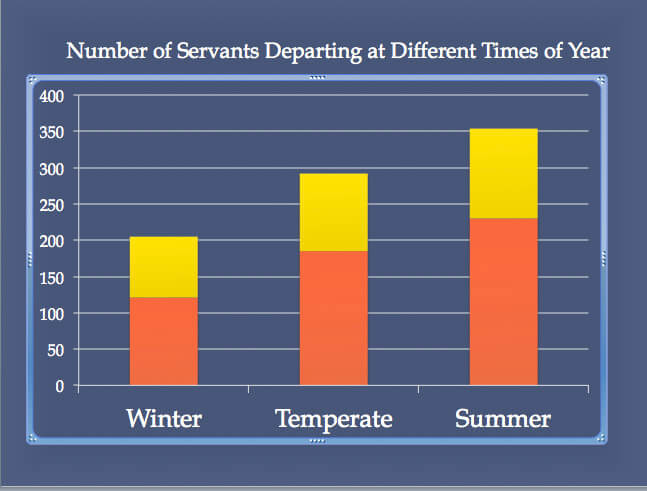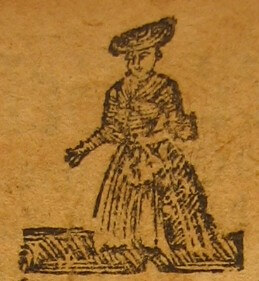Many of us choose some aspect of life to rejuvenate on the 1st of January. On a whim, I decided to reference my runaway servant research database to see how popular a day New Year’s Day was for running away. My study focuses on indentured and enslaved women living in North America, 1750-90, who were advertised for recapture in newspapers (read a previous post on the project). I used this information to create a database of 1,000 women and their 6,000 garments. Additionally, the database can be used to study languages spoken, hair color, aptitudes and habits, and other information.

Numbers of servants in the study running away during different times of year. Temperate represents Spring and Fall. Yellow represents enslaved women, while red represents indentured women. RL Fifield chart.
I found twelve women who chose to elope on New Year’s Day; interestingly, this is the greatest number of runaways in my study that ran away on a single day. Believably, sixty percent of these women lived in the South. And 9 of the 12 women were enslaved; most of these women lived in the South, except for Mary, who ran away from New London, Connecticut in 1773.
Logically, many of the servants in the study ran away during the warmer months. But the motivations to run knew no season, and twenty percent of the women in my study absconded from their masters during the winter. The ability to analyze information in this way can educate us about how the working classes dressed against the winter cold. Woolen fabrics and layering were employed. Mary wore a black and white drugget gown, Nancy wore a dark striped stuff gown upon her elopement from Charleston, SC in 1785, and Mary Diggens wore a brown damask gown with velvet cuffs, pink durant petticoat, and a white silk bonnet when leaving Dover, DE in 1768.
But New Year’s Eve was not a popular date for beginning new ventures: only one woman of the 1,000 in the study, Mary Young of Philadelphia, made off just before the start of 1759. She wore a calico petticoat over a linsey one, a “half worn very small black Bonnet”, “a dark Manchester Cotton narrow striped Gown”, topped with a short light-colored cloak.
This project has benefitted from digitization of historic newspaper collections, especially those held by the American Antiquarian Society. These projects are so important as they help us ask new questions and spur on the development of the next generation of digital resources that help us to analyze the information contained within historic documents. Preserving access through digitization is the first step to a greater understanding of those less documented in history.


i found your blog while researching Maryland food something or other and just had to leave a comment to mention how i’ve been enjoying it.
i’ve created a little Maryland food database and am appreciating our shared interests in architecture, research databases, Maryland food AND being opinionated (along the same lines) about transit. happy new year.
Hi Kara – nice to hear from you and I’m glad you are enjoying the blog. I’d like to write more frequently, but have been a bit hard-pressed since my son’s arrival! I’d love to hear more about your Maryland food database – I think Maryland gets overlooked beyond the crab cake. Do you have a website?
“Maryland gets overlooked beyond the crab cake” I certainly couldn’t agree more!
I had started a blog before the database but then got inspired to create it and have been slowly plugging away at that as time allows since. (http://oldlineplate.blogspot.com/)
I hope to use it to begin the blog again this year. It connects facts and photos about various recipes, persons, ingredients etc but as you imagine the amount of information is potentially endless. (i’m not a historian, just an office drone.)
as for frequent blogging.. quality over quantity.. I and probably most of your readers use a blog reader anyway so we’ll see an entry when you’re inspired to make one! I’ve bookmarked it future reference. take care
Good luck – I like what you are doing with recipes on your website. You know about Fifty Years in a Maryland Kitchen, right? Great recipes – that book was a reprint in the 1880s, so the original book was from the 1830s. https://archive.org/stream/fiftyyearsinama00collgoog#page/n5/mode/2up
I love that book. Blogging is a commitment, but I find it very satisfying. Best, Becky
now that you mention it I recall I found I might have found your site while researching that book. Outside of “Eat Drink & Be Merry In Maryland” there is a lot of repetition among the many Maryland cookbooks so I wasn’t sure whether to obtain a copy of that one or just refer to it at the library until I came across so many other references to it.